Vtne large animal Study guides, Class notes & Summaries
Looking for the best study guides, study notes and summaries about Vtne large animal? On this page you'll find 105 study documents about Vtne large animal.
Page 3 out of 105 results
Sort by
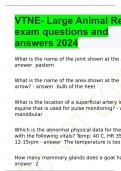
-
VTNE- Large Animal Review exam questions and answers 2024
- Exam (elaborations) • 14 pages • 2024
- Available in package deal
-
- $14.99
- + learn more
What is the name of the joint shown at the arrow? pastern What is the name of the area shown at the large arrow? bulb of the heel What is the location of a superficial artery in the equine that is used for pulse monitoring? mandibular Which is the abnormal physical data for the equine with the following vitals? Temp: 40 C, HR 35bpm, RR 12-15rpm The temperature is too high How many mammary glands does a goat have? 2 What is the angle (in degrees) of exposur...
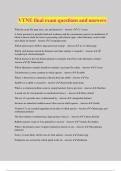
-
VTNE final exam questions and answers
- Exam (elaborations) • 25 pages • 2024
-
- $12.49
- + learn more
VTNE final exam questions and answers What the usual life span mice, rats and hamsters? - Answer ️️ -C) 3 years A ferret presents for periodic hind end weakness and the veterinarian suspects an insulinoma. If blood is drawn while the ferret is presenting with clinical signs, what laboratory result would most likely be found? - Answer ️️ -a hypoglycemia Which species gives birth to large precocial young? - Answer ️️ -d.) d. Guinea pig Which viral disease carried by hamsters and ...
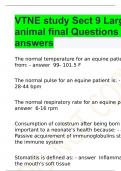
-
VTNE study Sect 9 Large animal final Questions and answers
- Exam (elaborations) • 15 pages • 2024
- Available in package deal
-
- $14.99
- + learn more
The normal temperature for an equine patient ranges from: 99- 101.5 F The normal pulse for an equine patient is: 28-44 bpm The normal respiratory rate for an equine patient is: 6-16 rpm Consumption of colostrum after being born is important to a neonate's health because: Passive acquirement of immunoglobulins strengthens the immune system Stomatitis is defined as: Inflammation of the mouth's soft tissue Pinkeye or contagious conjunctivitis in cattle is c...
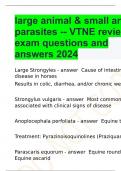
-
large animal & small animal parasites -- VTNE review exam questions and answers 2024
- Exam (elaborations) • 10 pages • 2024
- Available in package deal
-
- $13.99
- + learn more
Large Strongyles Cause of intestinal disease in horses Results in colic, diarrhea, and/or chronic weight loss Strongylus vulgaris Most commonly associated with clinical signs of disease Anoplocephala perfoliata Equine tapeworm Treatment: Pyrazinoisoquinolines (Praziquantel) Parascaris equorum Equine roundworm or Equine ascarid Causes disease in foals: - Poor weight gain - A heavy burden of large worms result in intestinal impaction - The larvae migrate through ...
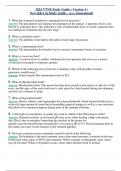
-
2024 VTNE Study Guide ( Version 4 ) New Q&A in Study Guide - A++ Guaranteed!
- Exam (elaborations) • 17 pages • 2024
-
Available in package deal
-
- $11.99
- + learn more
2024 VTNE Study Guide ( Version 4 ) New Q&A in Study Guide - A++ Guaranteed! 1. What doesit mean if an animal is a paratenic host of a parasite? Answer: The parasitedoes not undergo development on the animal. A paratenic host is also known as atransport host. This indicates a type of intermediate host on which a parasite does not undergo development into the next stage. 2. What is a definitive host? Answer: The definitive host harbors the adult, sexual stage ofa parasite 3. What is a ...
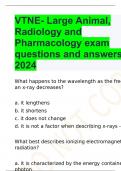
-
VTNE- Large Animal, Radiology and Pharmacology exam questions and answers 2024
- Exam (elaborations) • 10 pages • 2024
- Available in package deal
-
- $14.49
- + learn more
What happens to the wavelength as the frequency of an x-ray decreases? a. it lengthens b. it shortens c. it does not change d. it is not a factor when describing x-rays a What best describes ionizing electromagnetic radiation? a. it is characterized by the energy contained in a photon b. it occurs only in nature and is not human made c. it does not damage tissues d. it has a wavelength much longer than that of visible light a What is a property of x-rays? a. they c...
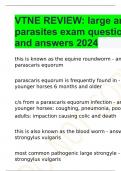
-
VTNE REVIEW: large animal parasites exam questions and answers 2024
- Exam (elaborations) • 9 pages • 2024
- Available in package deal
-
- $12.99
- + learn more
this is known as the equine roundworm parascaris equorum parascaris equorum is frequently found in younger horses 6 months and older c/s from a parascaris equorum infection younger horses: coughing, pneumonia, poor growth adults: impaction causing colic and death this is also known as the blood worm strongylus vulgaris most common pathogenic large strongyle strongylus vulgaris what parasite can cause blockage of the cranial mesenteric artery in horses st...
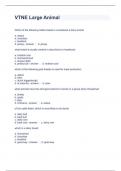
-
VTNE EXAM BUNDLE 2024
- Package deal • 20 items • 2024
-
- $40.49
- + learn more
Exam (elaborations) VTNE 4 QUESTIONS AND ANSWERS FULLY SOLVED Exam (elaborations) VTNE B QUESTIONS AND ANSWERS FULLY SOLVED Exam (elaborations) VTNE Large Animal Questions and Answers Graded A+ Exam (elaborations) VTNE Practice exam (form B) Questions and Answers 2024 Exam (elaborations) VTNE Practice Exam D Questions and Answers 100% Accu
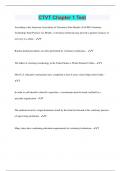
-
CTVT Chapter 1 Test
- Exam (elaborations) • 8 pages • 2024
-
- $9.99
- + learn more
CTVT Chapter 1 Test According to the American Association of Veterinary State Boards (AAVSB) Veterinary Technology State Practice Act Model, a veterinary technician may provide a patient's chances of recovery to a client. - F Routine dental procedures are often performed by veterinary technicians. - T The father of veterinary technology in the United States is Walter Emmett Collins - T Most U.S. educated veterinarians have completed at least 8 years of post-high school study. - T...
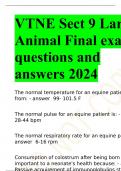
-
VTNE Sect 9 Large Animal Final exam questions and answers 2024
- Exam (elaborations) • 12 pages • 2024
-
- $14.99
- + learn more
The normal temperature for an equine patient ranges from: 99- 101.5 F The normal pulse for an equine patient is: 28-44 bpm The normal respiratory rate for an equine patient is: 6-16 rpm Consumption of colostrum after being born is important to a neonate's health because: Passive acquirement of immunoglobulins strengthens the immune system Stomatitis is defined as: Inflammation of the mouth's soft tissue Pinkeye or contagious conjunctivitis in cattle is c...

How much did you already spend on Stuvia? Imagine there are plenty more of you out there paying for study notes, but this time YOU are the seller. Ka-ching! Discover all about earning on Stuvia


